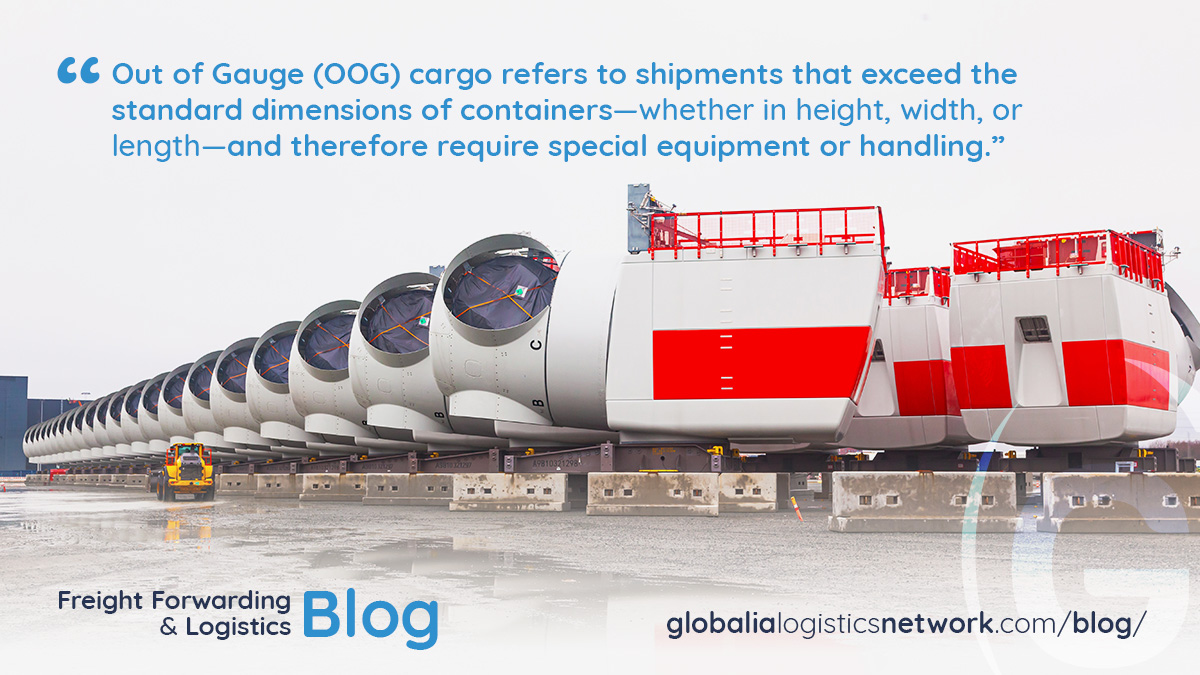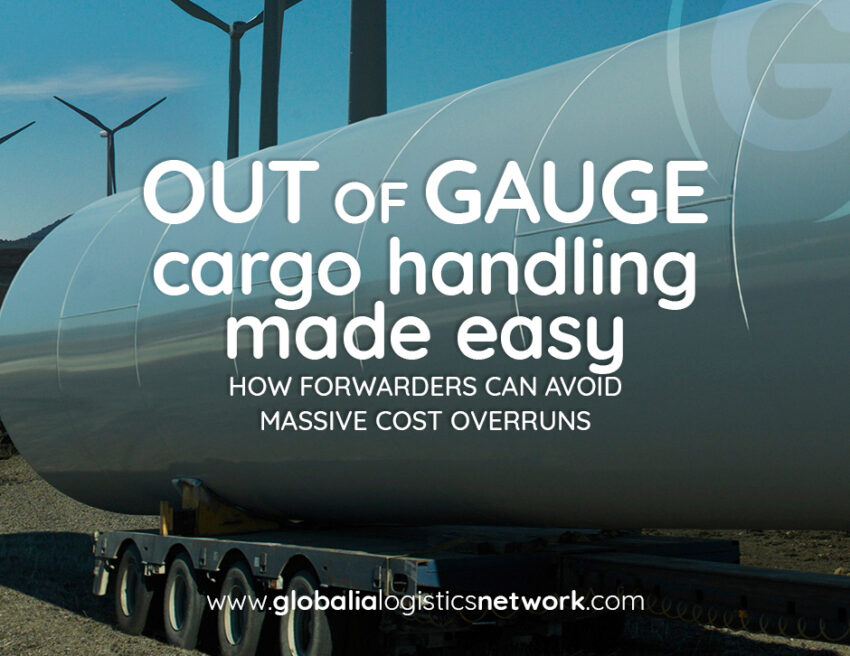In the world of project logistics, nothing derails timelines or budgets like out-of-gauge (OOG) cargo handling gone wrong. Whether it’s a 12-meter wind turbine blade, a transformer for a power plant, or a mining excavator too wide for a standard flat rack, OOG shipments come with more than just size complications. They demand technical precision, regulatory foresight, and rock-solid coordination.
And yet, many freight forwarders, even experienced ones, still underestimate what it takes to move over-dimensional cargo efficiently. The result? Unexpected cost blowouts, missed delivery windows, rejected permits, or worse, damaged cargo.
This guide breaks down everything you need to know to master out-of-gauge cargo handling without burning a hole in your client’s budget—or your reputation.
What is Out of Gauge Cargo?
Before we get into strategy, let’s define what we mean by OOG. Out-of-gauge cargo refers to shipments that exceed the standard dimensions of containers—whether in height, width, or length—and therefore require special equipment or handling.
Common examples include:
-
Machinery and industrial equipment
-
Structural steel
-
Wind and solar energy components
-
Prefabricated construction elements
These shipments typically don’t fit into standard 20’ or 40’ containers and may require:
-
Flat racks
-
Open-top containers
-
Breakbulk or RO-RO (Roll-on/Roll-off) handling
-
Specialized trucks, cranes, or escorts

The Hidden Costs of Poor OOG Planning
Here’s the truth: Out of gauge cargo handling isn’t just about booking a flat rack and hoping for the best.
Forwarders who take a one-size-fits-all approach often face:
-
Overweight or dimension-based surcharges
-
Unexpected port handling fees
-
Missed connections or vessel rollovers
-
Rejections from customs or port authorities due to incorrect permits
-
Damage to high-value equipment during loading/unloading
-
Last-minute storage and demurrage charges
In many cases, these costs aren’t covered by insurance if they’re caused by negligence or poor planning. That’s why every forwarder dealing with OOG shipments needs to get serious about risk mitigation.
Step-by-Step Guide to Smarter Out-of-Gauge Cargo Handling
1. Start with Accurate Dimensions—Down to the Millimeter
Misdeclared dimensions are one of the top reasons OOG shipments go over budget. If your client sends an estimated width or height “from the manufacturer,” don’t accept it blindly.
Best Practice:
Conduct a physical survey or request a certified measurement report. Include projections like protruding parts, securing mechanisms, or bolted accessories.
This is your baseline for route planning, permit applications, and equipment booking.
2. Pre-Plan the Transport Route
Not all roads, ports, or terminals are created equal. A piece of equipment that fits on a flat rack may still be rejected at port gates if local infrastructure can’t accommodate it.
When it comes to out of gauge cargo handling, you must consider:
-
Bridge height clearances
-
Load restrictions on roads
-
Port terminal OOG handling capabilities
-
Equipment availability at destination
-
Weather conditions (especially for open transport)
Pro Tip:
Use route planning software or coordinate with local agents who are familiar with regional challenges. Networks like Conqueror Freight Network can provide access to reliable on-the-ground expertise.
3. Choose the Right Container and Securing Method
Selecting between flat racks, open-top containers, breakbulk, or RO-RO isn’t just about size—it’s about safety and budget optimization.
Flat Rack? Ideal for cargo that exceeds container height or width but can be loaded from the top or side.
Open-Top? Good for cargo with awkward height but still within width limits.
Breakbulk? Often needed for massive, indivisible cargo pieces.
RO-RO? Perfect for wheeled machinery or when minimal lifting is required.
Out of gauge cargo handling also means planning how the cargo will be secured:
-
Lashing with chains or straps
-
Use of blocking, bracing, or cribbing
-
Load distribution to avoid structural stress
4. Don’t Skip Local Permits and Escorts
If your OOG cargo is being moved overland, most countries (and even regions within countries) have strict regulations on transporting over-dimensional loads.
You’ll likely need:
-
Oversized transport permits
-
Police or private escorts
-
Night transport approvals
-
Route deviation approvals
-
Bridge or road reinforcement notices
Missing a single permit can delay your shipment for days—or weeks.
Tip:
Apply for permits well in advance. Engage a local specialist if you’re moving cargo into difficult regions (e.g., mountainous terrain or congested city ports).
5. Account for Lift Equipment Availability and Capacity
In many ports—especially in developing regions—lift equipment like cranes or heavy-duty forklifts may not be readily available or may have long wait times.
Coordinate in advance to ensure:
-
Availability of crane slots at port terminals
-
Appropriate lift capacity for both origin and destination
-
Standby crews during weekends or holidays
This is particularly important when handling project cargo or moving goods under tight construction or assembly schedules.
6. Build a Buffer into Your Budget and Timeline
Out of gauge cargo shipments are inherently unpredictable. Weather delays, permit processing times, or last-minute equipment issues can throw a wrench into even the most detailed plan.
Include a 10–15% contingency in your costing, and advise clients to prepare for potential hold-ups—especially in cross-border or multi-modal routes.
This proactive transparency is not only professional—it strengthens client trust.
7. Document Everything—From Load Photos to Lashing Diagrams
Detailed documentation is your safety net. In the event of damage, customs questions, or insurance claims, you’ll need evidence of how cargo was secured, loaded, and handled.
Include:
-
Pre-loading survey reports
-
Lashing certificates
-
Weight distribution plans
-
Port handling documentation
-
Full photographic records
This isn’t just good practice—it’s essential for managing risk in out of gauge cargo handling.
Wrapping Up: OOG Shipments Are High Risk, But Also High Value
Freight forwarders who can confidently manage out-of-gauge cargo handling build a reputation as problem-solvers, partners that can handle complex logistics challenges without spiraling costs. By getting the basics right—accurate measurements, proper container selection, regulatory compliance, and realistic budgeting you position your team to win more high-margin, specialized business. And in a competitive market, that’s the edge that matters.
Are You OOG-Ready? If you’re part of Globalia Logistics Network, don’t hesitate to collaborate with members in other territories when handling OOG cargo. Their on-ground knowledge can help reduce both risk and cost.


